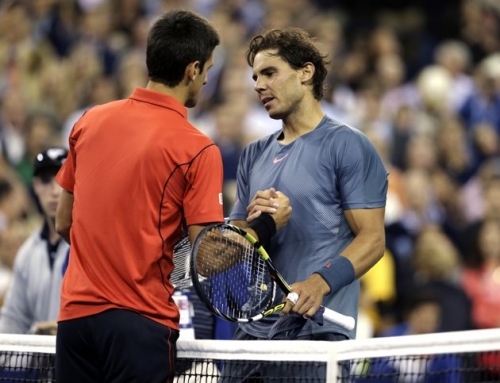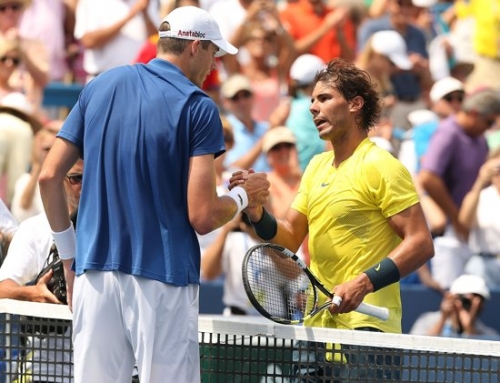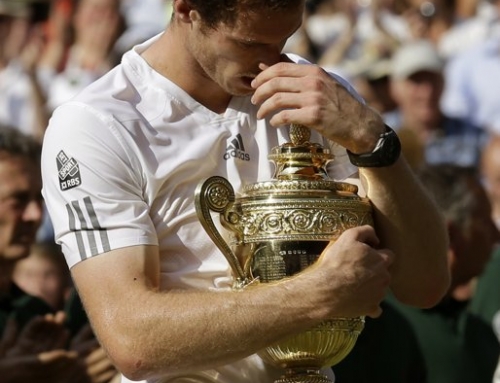 Ivan Lendl was announced as Andy Murray’s coach. Murray had been looking for a new coach for almost a year and a half. He struggled to find someone with the clout to give him advice that might win him a Slam, and someone that could travel with him about 25 weeks of the year. He wanted a coach that would travel with him during the Slams and the majority of the Masters 1000.
Ivan Lendl was announced as Andy Murray’s coach. Murray had been looking for a new coach for almost a year and a half. He struggled to find someone with the clout to give him advice that might win him a Slam, and someone that could travel with him about 25 weeks of the year. He wanted a coach that would travel with him during the Slams and the majority of the Masters 1000.
This turns out to be tough. Most guys that have recently coached, say Darren Cahill, still have parental duties. For Cahill to commit to any player means being away from home about half the year and many are not willing to do that. Of course, there are a few veterans, say, someone around the age of Tony Roche, that would have no such problems, but their age would prevent them from traveling regularly.
In a way, Lendl kinda just dropped in Murray’s lap. Lendl retired from tennis at the end of 1994 with back issues. His back issues continued to plague him for another 15 years, although he was healthy enough to play some golf. Eventually, he found a doctor who could treat his back, and he began to train to play tennis once again. Lendl played about a year ago. And once Lendl could travel to play tennis, he could travel to coach.
Lendl’s game is particularly interesting because he put so many wrinkles in game. Initially, Lendl had a pretty big serve, big forehand, but mostly a slice backhand. One has to recall that many players of the day were still playing the classic Australian or American serve-and-volley style. Australians, in particular, used a Continental grip for all their shots: forehand, backhand, volleys, and serve. They believed in the chip-and-charge, the slice return and run to net. Since many tournaments were played on grass which could get muddy and torn up, this was a good way to hit.
The Europeans, meanwhile, stayed focused on clay and built a game around topspin, but not much power. Many clay courters lacked good serves or volleying skills. So, Australians often did just as well on clay, imposing their game and doing the best they could, or occasionally, there was a baseliner like Ken Rosewall, who was a steady player and could rally with the clay courters.
Even so, that slice backhand was a liability. Lendl said he had to serve and volley on occasion to hide this weakness. He eventually decided he needed a topspin backhand. He worked with Wojtek Fibak, a Polish player, with a one-handed backhand, and they worked on a technically sound topspin backhand which contrasted with his improvised forehand. Once that topspin backhand became reliable, Lendl really became dangerous.
Lendl discovered several things. First, his forehand was more powerful than his backhand, so he opted to run around his backhand. He wasn’t the first player to do this. John Newcombe was famous for running around his backhand, but Newcombe hit much flatter than Lendl. Lendl would use his forehand to attack an opponent’s backhand with his inside out forehand. Lendl also realized his power would allow him to play much shorter points.
It was said, during Lendl’s early years, that the only pros that could hit winners from the baseline was Borg, Vilas, Connors, and Lendl. And frankly, Borg, Vilas, and Connors didn’t hit a lot of winners off the ground. Lendl, didn’t hit a ton of winners, but just that he could thread the needle down the line when he was pulled wide using a groundstroke like a passing shot was incredible for its day. Where Lendl’s topspin really succeeded was on passing shots. Players had to hit a really good approach for Lendl to miss. Now, in those days, passers weren’t nearly as good as today’s players. A player ranked 20 can often pass Federer and Nadal if they come to net. Great players look ordinary at net. Lendl, meanwhile, was only pressured by the very best: McEnroe, Connors, Becker, and Edberg.
Lendl’s big serve also meant he held serve more easily than some of his clay court rivals. Vilas struggled his entire career to get his serve better, but could never boom it. The serve was also a big reason for Borg’s success. He could win a few free points off his serve, even as he was the premier baseliner.
Lendl had the kind of power to win Slams. He made four Slam finals early in his career. He lost to Borg in the 1981 French Final, then to Jimmy Connors at the 1982 US Open, then Mats Wilander at the 1982 Australian Open, and finally once again to Connors in the 1984 US Open. Connors power and his desire to come to net was enough to handcuff Lendl. Early on Lendl found much more success beating McEnroe by intimidating him, often trying to hit him. McEnroe would retreat to the baseline and Lendl would dominate him from the backcourt.
However, Lendl couldn’t seem to get over the hump. Lendl decided to do two things. He began watching his diet. Initially, he lost a bit too much weight and looked a bit gaunt until he controlled that aspect. In the old days, many players were content with burgers and beers and didn’t really pay attention to what they ate. Second, Lendl began working off-court, doing weight-training. Until then, most players had thought working with weights would make you muscle-bound and slow, so few players bothered with weight-training.
Lendl wasn’t the only player looking at diet and weight-training. Indeed, Martina Navratilova was even more famous. She had hired Nancy Lieberman to get Martina in great physical shape. In the 1970s, Martina was heavy enough that Bud Collins dubbed her “The Great Wide Hope” as a riff on “The Great White Hope”. Martina lost weight and built practice sessions that were much harder than what she was used to. She said she wanted real matches to feel like practice. And for a while, it worked, as Martina would win matches under an hour routinely.
Lendl didn’t quite do this. His progress was slower. Lendl wanted to deal with two of his biggest opponents, both Americans. Bjorn Borg had retired by the end of 1981, so he was no longer someone Lendl had to worry about. Lendl then discovered a way to play Connors. If he had paid attention to Arthur Ashe in the Wimbledon final of 1975, he might have picked on it earlier. Lendl realized Connors loved power, and he was giving Connors power all the time. So Lendl began pulling back, slicing his backhand, and giving Connors no pace. This strategy culminated in a 6-0, 6-0 drubbing in the 1984 WCT Forest Hills semifinals, played on Har-Tru. There’s probably never been a defeat of one top 4 player by another at love and love without injuries.
Lendl would, of course, lose to Connors a few more times, but this gave him a way to play Connors. And realize, Connors was already around 30 by 1980, so he wasn’t getting any younger. Time would be Lendl’s ally if his shots weren’t always there.
Lendl needed a critical victory to finally break the Slam jinx. Lendl often referred to Tom Watson who won his first golf Slam at a late age (though, Watson didn’t seem to “lose” or come in second that much–such is golf). Lendl faced John McEnroe in the finals of the French Open in 1984. McEnroe had never performed well on clay. Connors was a far better clay-courter despite never reaching the final of the French Open. But 1984 was his best year, and his chip-and-charge strategy actually worked and got him to the finals.
For two sets, McEnroe was untouchable. Lendl struggled to get shots back and compete. McEnroe even had an early lead in the third set. Lendl struggled but finally broke and took the third set. By that point, McEnroe was beginning to struggle with his first serve percentage, and this allowed Lendl to keep in McEnroe’s serve. The two actually played pretty even until the very end when McEnroe pushed a routine volley out wide.
For Lendl, this was a huge mental burden. He barely won his first Slam. He would reached the 1984 US Open final and lose there too, but Lendl seemed reliable to reach two Slam finals a year.
Now you might ask, what makes Lendl the father of modern tennis. Modern tennis is all about the huge forehand and winning points by punishing the short ball. Key to this strategy is topspin. Players from Australia and the US hit flat because they felt it offered the most power. When one hits with topspin, some of the energy goes into the spin itself. The ball also bounces high. Many flat players felt this height made topspin unworkable for approaching the net.
While the modern power game bears little resemblance to today’s game, it started with Lendl. Soon, other players began hitting in this way. The first player to hit with the huge forehand was Jimmy Arias. He was the closest to Lendl in power, but Arias was quite a bit shorter than Lendl, so this created problems. He also lacked a big serve and wasn’t a particularly good volleyer. The second player that played this style was Aaron Krickstein. Krickstein had the second part of today’s modern game which is the two-handed backhand. It also didn’t hurt that he was about 6 ft tall, much taller than Arias. His career lasted far longer than Arias.
The third, and most important player, to have this big style was Andre Agassi. One thing that Agassi, Krickstein, and Arias shared in common? Nick Bollettieri He believed that you should have one big weapon, namely, the forehand, and you should be able to dictate with that shot. Lendl was playing this style a few years before Arias first came on the scene. The only other early player that played this big style was Boris Becker, who had one thing these other players didn’t have: a big serve. Indeed, this is main reason that Lendl struggled against Becker.
Lendl discovered that his modern style was not enough for him to win matches. So, he began adding more elements to his game. When Lendl was first rising in the ranks in the early 1980s, he almost exclusively topspin on his backhand. By the mid 1980s, he began slicing a lot more, including passing shots, using the angles he could create using slice to pass bewildered opponents.
Lendl also did other things to gain an edge. The tour had created a time limit between points. At the time, it was 35 seconds. They thought players were deliberately slowing down in between points, so the time limit would be good. However, in the days of the Aussies, players got ready for points exceedingly quick, within 10 seconds or so. Lendl realized he could take advantage of this and began milking the entire clock, trying his racquet handle, and playing slow. He deliberately tried to disrupt the rhythm of other players. They eventually had to reduce the time between points to 25 seconds because of this.
Lendl also noticed that players like Connors and McEnroe would use their tempers to intimidate chair umpires and even their opponents. Lendl didn’t care that he looked like the bad guy when he complained. He wanted to get his complaint and give himself a chance to win these battles.
Lendl looked at other ways to control his success. He hired Warren Bosworth to make sure all his racquets were identically strung and weighted. Prior to that, players often went to a racquet factory, and were given 40 racquets which they had to pick 6 or so that weighed the same, such was the lack of fine tolerance in those days. Lendl switched racquets after every ball change. One time, he pulled out a racquet from his bag, and it was still wrapped in plastic. The ESPN announcer was shocked thinking he had been sent a racquet straight from the factory. In those days, players only switched racquets if it broke or if they didn’t like the tension. Lendl decided tension loss was enough of a problem that he switched to make sure it played the same.
Lendl wanted to make sure his courts at his New Haven home, maybe an hour from Flushing Meadows, was identical to the ones at the US Open, so he’d hired the guys who laid out the courts. Lendl wanted to control every variable he could.
Lendl was one of the first to invite up-and-coming players to hit with him. In particular, Pete Sampras practiced with Lendl. It benefited Lendl who got a close look at promising talent without giving away too much to his rival, and even the juniors that came to hit learned what it meant to be a professional.
Since then, players like Federer have imitated the Lendl model and even extended it beyond what Lendl did. Federer worries about his hand-eye coordination. He has a drill where there are three tennis balls with three colored dots. He must hit each ball in a certain order before they bounce. Federer has a physio in Paganini who monitors how Federer’s body is holding up. If he seems weak, he spends time either strengthening or resting, depending on what he needs. Federer creates these shot scenarios which he repeats over and over, attacking a short ball, then taking the next ball and perhaps hitting it inside-in.
Most players these days work a great deal on their core rotation and their agility, making sure they stay balanced, even as they move very fast. They do drills that don’t even resemble tennis so they can handle odd shots. Every notice how almost no pro struggles with chasing down the drop shot. They’ve done drills to chase down these shots so often they know what to do in each situation. Federer even practices the tweener despite hitting it less than once a tournament. In the old days, you would see a player like Arthur Ashe dump a easy ball into the net. Today, that wouldn’t happen. He would work on this shot very hard. Arguably, Ashe never practiced this shot because he thought it was too rare to even bother.
In the old days, players had huge gaps in their games. Serve and volleyers struggled mightily if they had to play baseline. Baseliners struggled with hitting technically sound volleys. Indeed, a player as great as Borg and Connors never learned to hit a traditional slice backhand. Today, with the plethora of two-handed backhands dominating the game, the slice backhand is still a must. Players who play almost exclusively from the baseline often volley much better than their counterparts in the 1970s.
More than any other player, Ivan Lendl not only created the modern power forehand game, but also did as much as he could off the court to improve his game. What other player learned to play serve-and-volley (albeit a bit awkwardly) just so he could Wimbledon? He didn’t win it, but he gave himself chances by reaching the finals twice and the semis five times. That was far better than players that were deemed grass court players, like Tim Mayotte. And while he didn’t reach all his goals, perhaps far fewer than his talent should have garnered, he did more than any other player to give himself the best chance to win exploring areas that no other player considered, and his commitment has become the standard by which all modern players train for the sport.




![[US Open Men’s Final] Can Djokovic beat Nadal in the finals?](https://www.essentialtennis.com/wp-content/uploads/2013/09/20130909djokovic-500x383.jpg)


![[French Open] The tactics of the Djokovic-Nadal semifinals](https://www.essentialtennis.com/wp-content/uploads/2013/06/20130607nole-500x383.jpg)